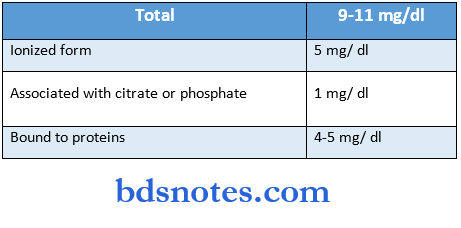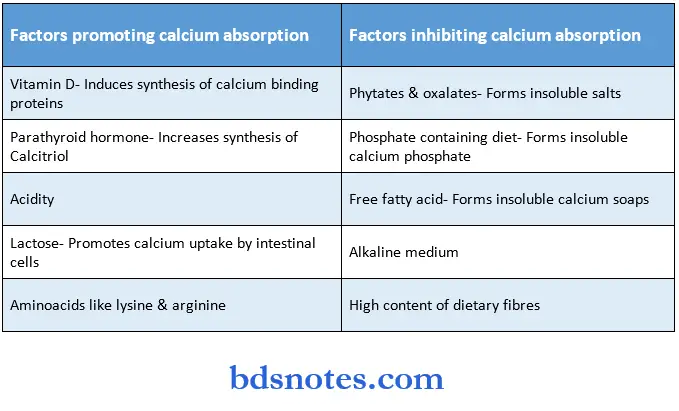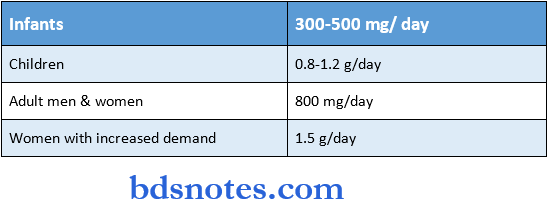Inorganic Substances
Question 1. What is the normal serum calcium level? How is it regulated? Enumerate the physiological functions of calcium. (or) What is the normal blood calcium level? What are the factors which maintain this level? (or) Functions of calcium (or) Regulation of serum calcium (or) Calcium homeostasis (or) The normal level of serum calcium Four functions of calcium
Answer:
Normal serum calcium level:

Read And Learn More: BDS Previous Examination Question And Answers
Regulation of calcium/ hemostasis
- Calcium level is regulated by
- Calcitriol
- It is the active form of the vitamin D
Mechanism
-
- Induces synthesis of calcium-binding protein
- This increases calcium absorption by the intestine
- This increases calcium level
- It also promotes calcification & remodeling of bone
- Parathyroid hormones
- Secreted by Parathyroid glands
Mechanism
-
- Binds to a membrane receptor protein
- Activates adenylate cyclase
- Liberates cAMP
- Increases intracellular calcium
- Action on bone
- Stimulates pyrophosphatase & collagenase
- Causes decalcification of bone
- Results in bone resorption
- Action on the kidney
- Stimulates 1-Hydroxylation of 25-hydroxy cholecalciferol
- Promotes production of Calcitriol
- Action on intestine
- Promotes synthesis of Calcitriol
- Increases calcium absorption
- Action on bone
- Calcitonin
- Secreted by parafollicular cells of thyroid gland Mechanism
- Increases osteoblastic activity
- Promotes calcification
- Decreases bone resorption
- Increases calcium excretion
- This decreases blood calcium level
- Secreted by parafollicular cells of thyroid gland Mechanism
Functions of calcium:
- Development of bone & teeth
- Calcium is required for the formation of hydroxyapatite
- Bones serve as a reservoir of calcium
- Muscle contraction
- Calcium ions react with troponin C & trigger muscle contraction
- Activates ATPase
- Increases interaction between actin & myosin
- Blood coagulation
- Calcium is coagulation factor IV
- Nerve transmission
- It is involved in the transmission of nerve impulse
- Membrane integrity & permeability
- It influences the membrane structure
- Activation of enzymes
- It activates ATPase, lipase & succinate dehydrogenase
- Binds with calmodulin to activate certain enzymes
- It acts as a second messenger for certain hormonal actions
- Causes release of insulin, PTH, calcitonin
- Involved in endocytosis, exocytosis & cell motility
- Involved in cell contact & cell adhesion
- Acts on the myocardium & prolongs systole
Question 2. Write the dietary sources, factors influencing absorption, biochemical functions & daily requirements of calcium. (or) Factors affecting calcium absorption
Answer:
Answer:
Dietary sources:
- Milk & milk products are regarded as the best sources of calcium
- Other good sources of calcium are:
- Beans, leafy vegetables, fish, cabbage, egg yolk.
Factors influencing absorption:

Daily Requirements:

Question 3. Sources & functions of calcium i
Answer:
Sources of calcium:
- Milk & milk products are regarded as the best sources of calcium
- Other good sources of calcium are:
- Beans, leafy vegetables, fish, cabbage, egg yolk.
Functions of Calcium:
- Development of bone & teeth
- Calcium is required for the formation of hydroxyapatite
- Bones serves as a reservoir of calcium
- Muscle contraction
- Calcium ions react with troponin C & trigger muscle contraction
- Activates ATPase
- Increases interaction between actin & myosin
- Blood coagulation
- Calcium is coagulation factor IV
- Nerve transmission
- It is involved in the transmission of nerve impulse
- Membrane integrity & permeability
- It influences the membrane structure
- Activation of enzymes
- Iates ATPase, lipase & succinate dehydrogenase
- Binds with calmodulin to activate certain enzymes
- It acts as a second messenger for certain hormonal actions
- Causes release of insulin, PTH, calcitonin
- Involved in endocytosis, exocytosis &: cell motility
- Involved in cell contact & cell adhesion
- Acts on the myocardium & prolongs systole
Question 4. Hypokalemia
Answer:
- A decrease in the concentration of serum potassium is called hypokalemia
Causes:
- Overactivity of the adrenal cortex
- Prolonged cortisone therapy
- Intravenous administration of K+-free fluids
- Treatment of diabetic coma with insulin
- Prolonged diarrhea & vomiting
Symptoms:
- Irritability
- Muscular weakness
- Tachycardia
- Cardiomegaly
- Cardiac arrest
ECG changes:
- Flattening of waves
- Inverted T wave
Question 5. Absorption & transport of iron
Answer:
Absorption:
- Dietary iron is in the ferric form bound to proteins or organic acids
- The acidic medium of gastric juice releases this ferric ion
- Later it is converted to ferrous form by reducing substances like ascorbic acid & cysteine
- The ferrous form is soluble & is readily absorbed by mucosal cells
- It is oxidized to ferric form by ferroxidase
- This ferric form then combines with apoferritin & forms ferritin
- Iron from the mucosal cells may enter the bloodstream
- The ferric form is- Fe3+
- The ferrous form is Fe2+
Transport:
- Iron enters the plasma in a ferrous state
- Gets oxidized to ferric form, by a copper-containing protein, ceruloplasmin
- Ferric iron then binds to transferrin & is transported
Question 6. State the importance of fluoride
Answer:
- It is excreted by the kidney
- It passes the placental barrier
- Fluoride prevents the development of dental caries
- It converts hydroxyapatite to fluorapatite
- It is mostly found in bones & teeth
- It is deposited in other calcified tissues also
- It is required for the proper development of bones
- It inhibits the activities of certain enzymes
- Sodium fluoride inhibits enolase in glycolysis
- Fluoroacetate inhibits aconitase in the TCA cycle
Question 7. Fluorosis
Answer:
- Excessive intake of fluoride causes fluorosis
Types:
1. Dental Fluorosis
- Caused by fluoride intake above 2 ppm
- Its symptoms are:
- Mottling of enamel
- Discoloration of teeth
- Teeth become weak & rough
- Brown or yellow patches appear on their surfaces
2. Skeletal Fluorosis
- Caused by fluoride intake above 20 ppm
- It causes:
- Pathological changes in the bone
- Hypercalcification
- Bone density of limbs, pelvis & spine increases
- Ligaments of the spine & collagen of bones get calcified
- Neurological disturbances may also occur
3. Genu valgum
- It is an advanced stage of Fluorosis
- In it, individuals are unable to perform their routine work
- Joints become stiff
- Individuals are crippled
Question 8. Deficiency & excess of fluoride
Answer:
Deficiency:
Drinking water containing less than 0.5 ppm of fluoride causes the development of caries in children.
Secretion:
- It is secreted by Parathyroid glands
- Its secretion is promoted by low calcium concentration Actions
- It increases blood calcium levels by acting on bone, kidney & intestine
Question 9. Name the hormones which regulate serum calcium
Answer:
- Hormones regulating serum calcium levels are
- Calcitriol
- Parathyroid hormone
- Calcitonin
Question 10. Hypercalcemia
Answer:
- Elevation in serum calcium level is called hypercalcemia
Causes:
- Hyperparathyroidism
- Decrease in serum phosphate
- Increase in alkaline phosphatase
- Increase in excretion of calcium & phosphorus
Symptoms:
- Lethargy
- Muscle Weakness n Loss of appetite
- Constipation
- Nausea
- Increased myocardial contractibility a Susceptibility to fractures
Question 11. Parathormone
Answer:
- It is a single-chain polypeptide containing 84 amino acids
Synthesis:
- Synthesis as preproPTH
Question 12. Biochemical functions of phosphorus
Answer:
Phosphorus is required for
- Development of bone & teeth
- Formation of high energy phosphate compounds like ATP, GTP
- Formation of phospholipids, phosphoproteins & nucleic acids
- Several nucleotide coenzymes
- Activation of several proteins & enzymes
- Maintenance of blood pH
Question 13. Name two trace elements & their biological role
Answer:

Question 14. Potassium balance.
Answer:
- The plasma concentration of potassium is 3.4- 5 mFq/1.
- This level is maintained by a balance between potassium loss & potassium intake

Question 15. Importance of iodine (or) Give the sources & functions of iodine
Answer:
Sources:
- Seafood
- Drinking water
- Vegetables
- Fruits
Functions:
- Required for the synthesis of thyroid hormones
- Protein-bound iodine level decreases in hypothyroidism & increases in hyperthyroidism
Question 16. Write the metabolism of copper & iodine
Answer:
Metabolism of copper:
- About 10% of copper is absorbed mainly in the duodenum
- Metallothionine facilitates its absorption
- Metabolism of iodine
- Iodine is absorbed in the form of iodide
- 30% of it is taken up by mucosal cells, the rest by skin & lungs
- It is stored in the organic form of iodothyroglobulin in the thyroid gland.
- It is excreted through the kidney, saliva, bile, skin & milk
Question 17. Describe the functions & deficiency of fluorine
Answer:
Functions of fluoride:
- Fluoride prevents the development of dental caries
- It converts hydroxyapatite to fluorapatite
- It is required for the proper development of bones
- It inhibits the activities of certain enzymes
- Sodium fluoride inhibits enolase in glycolysis
- Fluoroacetate inhibits aconitase in the TCA cycle
Deficiency of fluoride:
- Drinking water containing less than 0.5 ppm of fluoride causes the development of caries in children
Question 18. Role of Fluoride in the Prevention of dental caries
Answer:
Fluoride prevents the development of dental caries
- It converts the hydroxyapatite of teeth to acid-resistant fluorapatite
- This forms a protective covering over the enamel
- This prevents tooth bacterial acids
- Fluoride also inhibits the bacterial enzymes
- This reduces the production of acids
Question 19. Dental Fluorosis
Answer:
- It is caused by fluoride intake above 2 ppm
- Its symptoms are:
- Mottling of enamel
- Discoloration of teeth
- Teeth become weak & rough
- Brown or yellow patches appear on their surfaces
Question 20. Biochemical functions of selenium
Answer:
- Along with vitamin E prevents the development of Hepatic necrosis & muscular dystrophy
- Maintains integrity of the membrane
- It is an essential component of glutathione peroxidase
- Protects cells against damage caused by hydrogen peroxide & free radicals
- Protects from carcinogenic chemicals
- Protects from toxic effects of heavy metals by binding to it
- 5-deiodinase, an enzyme containing selenium converts thyroxine to triiodothyronine
- Thioredoxin reductase, a selenoprotein is involved in purine metabolism
Question 21. Mention condition arising due to deficiency and excess of fluoride in the body
Answer:
Deficiency of Fluoride:
- Drinking water containing less Ilian 0.5 ppm of fluoride causes the development of caries in children
Excess of Fluoride:
- Excess of fluoride causes fluorosis
Types:
1. Dental fluorosis – it causes:
- Molding of enamel
- Discoloration of teeth
- Teeth become weak and rough
- Brown and yellow patches appear on their surfaces
2. Skeletal fluorosis- It causes
- Pathological changes in dead bone
- Mypercalcification
- Bone density of limbs, pelvis, and spine increases
- Ligament of the spine and collagen of bone gels calcified
- Neurological symptoms occur
3. Genu valgum
- It is an advanced stage of fluorosis
- Bones become stiff
- Individual is crippled
Question 22. Functions and deficiency of iodine
Answer:
Functions of Iodine:
- Required for the synthesis of thyroid hormone
Deficiency of Iodine:
- A deficiency of iodine leads to
Goitre:
- It is an abnormal increase in the size of the thyroid gland
- Simple endemic goitre
- Found in geographical regions away from the sea coast
Hypothyroidism:
- Characterized by reduced BMR, slow heart rate, weight gain, sluggish behavior, constipation, sensitivity to cold, dry skin
- In children, it leads to cretinism, and in adults it causes myxoedema
Question 23. Mention normal blood levels of calcium, cholesterol, urea, and creatinine.
Answer:
Normal Blood Levels:
- Calcium – 9-11 rng/dl
- Cholesterol -150-200 mg/dl
- Urea -15-40 mg/ dl
- Creatinine – 0.5 -1.5 mg/dl
Question 24. What are normal levels of the following:
- Serum phosphorous
- Serum cholesterol
Answer:
Normal Levels:
- Serum phosphorous – 3 – 4.5 mEq/1
- Serum cholesterol -150 – 200 mg/dl
Question 25. Sources and absorption of iron
Answer:
Sources:
- Liver
- Heart
- Leafy vegetables
- Iron cookware
Absorption:
- Dietary iron is in the ferric form bound to proteins or organic acids
- The acidic medium of gastric juice releases this ferric ion
Later it is converted to ferrous form by reducing substances like ascorbic acid & cysteine - The ferrous form is soluble & is readily absorbed by mucosal cells
- It is oxidized to ferric form by ferroxidase
- This ferric form then combines with apoferritin& forms ferritin
- Iron from the mucosal cells may enter the bloodstream
-
- The ferric form is- Fe3+
- The ferrous form is Fe2+

Leave a Reply